The Outer Dark
“Scott Nicolay analyzes horror like no one else out there. Give his show a listen, I guarantee you won’t regret it.”—Max Booth III, 8 Great Podcasts for Writers, LitReactor.com
“Scott Nicolay analyzes horror like no one else out there. Give his show a listen, I guarantee you won’t regret it.”—Max Booth III, 8 Great Podcasts for Writers, LitReactor.com
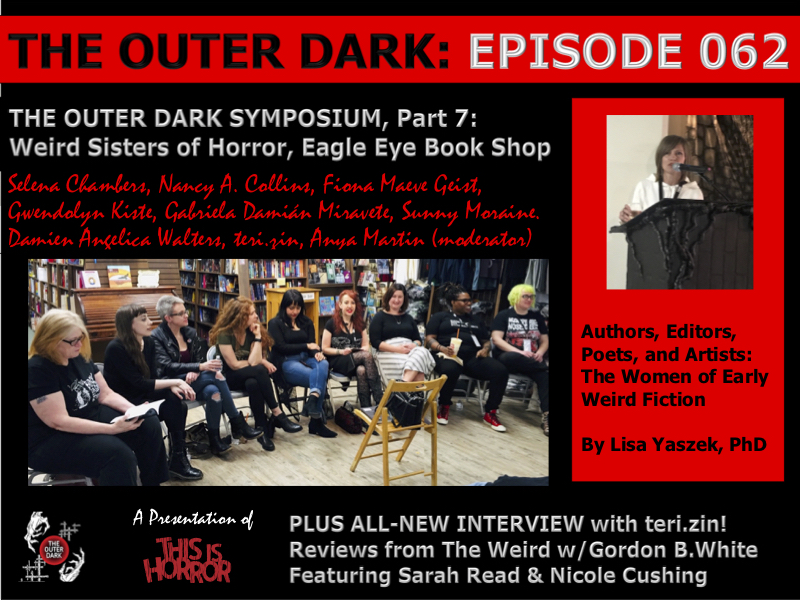
By Scott Nicolay
Originally published in The Outer Dark Symposium 2020 Program Chapbook
Technically, The Outer Dark Symposium for 2019 had ended the night before, and the large panel of female and nonbinary authors at Eagle Eye Book Shop in Decatur, Georgia on that Sunday afternoon last March1 was a coda, not an official part of the programming. But something that Anya Martin, Damien Angelica Walters, and Gabriela Damián Miravete collectively said during that discussion struck me as one of the most important statements on the state of Weird Fiction, not just from the symposium but from the last several years:
Anya Martin: Weird Fiction. . .gave voices suddenly to new authors from different perspectives. Voices to women, LBGTQ, Black women, Mexican women. We were writing this stuff before, not necessarily identifying with [Weird Fiction] but suddenly we had a category. And now we’re sitting at a moment where I’m hearing some men say it’s over—Weird Fiction is over as a marketing category right at this moment when this incredibly exciting [work is being done]. . .I know we don’t like labels in fiction, but it’s happening and here our moment is being robbed right back from us, taken away at this moment because we changed it.
Damien Angelica Walters: Yeah, we changed the narrative.
Anya Martin: It’s not Lovecraftian pastiche anymore.
Damien Angelica Walters: Now you have those who want the Lovecraftian pastiche who are saying, “Okay it’s done. You took it away. You changed it.” Instead of saying, “You have made it bigger.”
Gabriela Damián Miravete: “You ruined my child.”
Damien Angelica Walters: “You got your girl cooties in my fiction.”
These three authors were the first, to my knowledge, to call out this trend, which I believe represents the intersection, or rather the confrontation, of two trends. The first trend, and the most important, is the indisputable fact that a large part—perhaps the majority—of the best writing in Weird Fiction today is coming from women, from authors of color, from authors across the LGBTQIA rainbow, from authors belonging to so many important demographics that have long been disenfranchised by the publishing world. This has been the case for easily a decade now and probably longer.
The second trend was the small choir of voices, really not much more than a junior high glee club, proclaiming that Weird Fiction is over or dead. Predictably, these declarations have come almost unanimously from older white cis-men. Not all of these men speak from the same standpoint however, and it is important to differentiate their intentions. Some of the naysayers come from within Weird Fiction, some from without.
The first group includes figures who either immediately preceded the Weird Renaissance, i.e. had published their first book prior to the turn of the millennium or were among the first wave, authors who began publishing in the first half of the aughts. Some never adopted “Weird” as a descriptor for themselves or their work, but they repeatedly published in anthologies and venues that marketed themselves as “Weird” under one rubric or another, and they benefited from the Weird Renaissance well before I coined the term. By “benefited,” I refer to the increased readership they enjoyed because of the growing audience (as much in diversity as in numbers: a major factor in the Weird Renaissance was the expanded interest of diverse readers in Weird Fiction as well as other forms of Speculative Literature). Some of these authors have since “left” the Weird, or at least distanced themselves from it. Some did so quietly; a few drew attention to their rebranding. Nonetheless all of these authors helped get the Weird Renaissance rolling and keep it rolling.
Let’s be clear. No writer owes Weird Fiction anything, and no one owes any writer anything that is not in a contract. But words matter, and writers should know that better than anyone. Those who have acquired a platform and use that platform to proclaim the death of Weird Fiction might be knocking over the ladder before others get their chance to climb it. Let me be clear on another point though: every single author to whom the categories above might apply has done a great deal to promote other writers rising in their wake (I count myself among their beneficiaries). I cannot think of any of these authors who has not paid it forward time and again. Those who have walked away quietly are well within their rights to leave—but not to tear down what they left behind. The Weird now belongs to those who stayed. And to those yet to come.
“Those yet to come” because the Weird is not “dead.” It is not “over.” It has not slowed down and it has not stopped growing. Quite the reverse. And the Weird is diversifying. Rapidly. Wildly. Weirdly, beautifully, in weirdly beautiful ways.
Not a good time for good people to rain on that parade, although I don’t think any of the elder statesmen who wrote its premature obituary thought about it that way or had any such intent. But that’s what happens when we don’t think things through as perhaps we should. These are not villains, but the villains don’t care where they find their ammunition.
The most innocent of all are those who repeated the assertion that The Weird was dead as a lament, the authors who caught the wave during the last decade and were mourning the proclamation of its premature end. These authors simply despaired at the words of the predecessors they admired. Nonetheless, as we have seen with Russian troll-bot memes reshared on social media, the damage spreads regardless of the source.
Farther from the heart were the fans who routinely chase shiny genre objects. Over the last few years, some of these have shifted their gaze to folk horror, or some new flavor of body horror, or “quiet horror,” and so on. And so on. . . . These folks likely never saw Weird Fiction as anything beyond a subgenre of horror—which it is not, any more than it is a subset of science fiction, fantasy, mainstream literature, or any other genre—The Weird can live within them all. Such is the nature of fandom however, and this contingent was never a “base” that we could count on. It was never a base that anyone could count on. Easy come, easy go, don’t let the door hit you on the ass on the way out.
At the bottom of the barrel, or under the rock, are the usual suspects, the low-level puppy-adjacent trolls of the Lovecraft-o-sphere who continually push the bogus narrative that Weird Fiction begins and ends with the old boys’ club of the Farnsworth Wright era of Weird Tales, and their sad cadre of hackneyed champions who still plow over and over in those same tired ruts. Some of these folks thought they could run the show when it was still small enough to count the players on hands and toes, and they have done little but rant since it outgrew their fantasies of playing gatekeeper. They’ve trolled the community for the better part of a decade now, their voices growing ever shriller as their bandwidth has shrunk.
In sum, although some may have had good intentions when they proclaimed Weird Fiction dead or over, others repeated the proclamation only in mourning. But as we have seen with so much else these last few years, everything becomes toxic once the trolls get their hands on it.
The real truth is that the first two decades of this millennium have witnessed an unprecedented explosion of Weird Fiction, and far more authors are writing far more quality work in this field than ever before, Wright-era Weird Tales included.
Several years ago, I coined the term “Weird Renaissance” to describe this boom. I wanted a term that would encompass both “New Weird” and those of us who were simply “new” and “weird.” Unlike the short-lived “New Weird,”2 the Weird Renaissance is not a movement; it has no manifesto, no leaders, no followers, no membership. I never intended the phrase as anything more than a demographic descriptor—there’s nowhere to sign up—but if you’ve written one Weird Tale in the last 30 years, you’re part of it, like it or not. At the time, I had in mind similar literary explosions such as the Harlem Renaissance and El Boom. Predictably, the term met with some pushback and cost me at least one dear friend, though I feel much of this is due to a fundamental misunderstanding of my intent behind the coinage.
Though 21st century Weird Fiction is definitely an explosion, it is perhaps not quite a full supernova. It probably came closest to that scale right before True Detective backed away from The Weird at the end of its first season (following that embarrassing plagiarism scandal). And after all, wasn’t it always composed of both darkness and light?
Nonetheless, like an exploding star, The Weird may be dimming even as it expands. It is no longer so much a blinding light as an oscillating and membranous iridescence spanning vast distances between and betwixt the stars—while growing ever larger still. In this age of the rhizome and the cloud, call it the Weird Nebula. And that’s fine—perhaps we were only ever meant to see it clearly at night. After all, if it were obvious, it wouldn’t be Weird. The Weird is the literature of the other-than-obvious (among many other things—this is not a definition).
But why Weird Fiction, and why now? What fueled its explosion?
I argue that the explanation is simple: The Weird is one of the few epistemological standpoints that allows us to think meaningfully about a future that at the very least almost certainly includes the complete collapse of human civilization within the next two generations, and very likely means the extinction of our species and perhaps even most multicellular life on the Earth’s surface.2 In philosophy, this standpoint has manifested as the “Nonhuman Turn,” of which Object-Oriented Ontology and Speculative Realism are primary branches. Many of the key thinkers of the Nonhuman Turn have directly engaged with Weird Fiction: Eugene Thacker and Graham Harman with Lovecraft, Jane Bennett with Kafka’s Odradek, Timothy Morton and Jeff VanderMeer with each other. Reza Negarestani has actually written a major Weird novel, Cyclonopedia. Weird authors, alas, have been slower to engage with these ideas from the literary side.
I do not feel it is an oversimplification to suggest that at the heart of the Nonhuman Turn lies the intellectual project of grappling with the concept of a future in which humanity is no longer a presence but merely an expired ontological force. This is the work we will bequeath to the rocks, roaches, robots, rotifers, or raccoons that will follow us. As a central effort of the Nonhuman Turn is decentering humanity, it should be no surprise that some of its key figures see Lovecraft as important. The old racist from Providence was legitimately one of the first thinkers to articulate a philosophical position within which humanity was cosmically insignificant, completing the intellectual revolution begun by Galileo and Copernicus, not via scientific discoveries of his own, but through the creation of a conceptual language framed within the discoveries of the vast and seemingly incomprehensible nature of the universe emerging (then and now) from both astrophysics and particle physics (spiked with a generous dose of Fort and Blavatsky—Lovecraft’s science never rose above pseudoscience, and don’t get me started on his archaeology).3
Anya Martin has further pointed out that for women authors, “cosmic horror is equivalent to the existential dread of being trapped in an abusive relationship where all logic has broken down. You never know what will happen because the abuser has manipulated you into a constant state of confusion and fear, and at the same time you don’t leave.” In stories written from this perspective, the Weird element, be it monster, spacetime anomaly, or whatever other unknowable thing distorts the narrative fabric, may become the means of escape from the human monster. Similar processes are observable in the work of Black writers as well, a topic I have discussed on The Outer Dark in interviews with authors including Chesya Burke and Craig Laurance Gidney. For POC and especially for women of color, the supernatural may turn from a force of evil to an empowering—or at least liberating—force, because the reality it distorts is the toxic status quo, and the anomalies it creates may allow the oppressed some escape.
Anya and others have also pointed out that The Weird allows writers to address the transformation of the body in critical ways (critical both in the sense of important and as critical of previously dominant narratives)—from menstruation to pregnancy to menopause and all the manifold complexities that the body holds for queer and transgender people trapped in cis-het societies, as well as concerns related to disability and mental health. Ultimately, and I defer to Anya’s words again here, as I cannot say it better: “The Weird allows The Other to challenge mainstream perceptions of The Other in a way that other modes of fiction cannot.”
Thus, as I enter a new decade with the fatalistic thought that it may very well be the last one for our species and thousands of others, I once again make the case that imminent reality may be the reason for the exponential expansion of Weird Fiction over the last generation, the reason why Lovecraft appears so relevant despite his odiousness. However, I am fortunate that Anya Martin is around to keep me intellectually honest—to remind me that along with the Anthropocene, the Nonhuman Turn, and any Immanentizing Dystopia, the reason why The Weird is blowing up is the growing diversity of Weird Fiction.
For women, especially for women of color, for queer and transgender authors, the world was always a rigged game. The Weird, with its reality-melting power, allows visionary authors to see around the corner of the apocalypse, something that is difficult, if not impossible for white men like me, invested from birth in the power structure, to do in meaningful ways. Not surprisingly, Afrofuturist and African Futurist authors have already developed a wide range of approaches for exploring and envisioning viable futures. Not for the first time, I will point out that Weird Fiction writers, editors, and readers should look closely at the vast and vital world of Black Speculative Fiction, without which neither The Outer Dark nor The Outer Dark Symposium would exist.
If Lovecraft’s brand of cosmic horror has become more relevant in the full-on fascist world of 2020, so also have Bruno Schulz, Shirley Jackson, Franz Kafka, Octavia Butler, and a host of authors who have only begun publishing in the last two decades, many of them authors at whom Lovecraft and his chums would have turned up their noses. These authors are the strength of Weird Fiction today; they are the ones who are carrying it forward to an equally diverse audience and in unprecedented ways.
¡Viva la diversidad!
Notes
1“Weird Sisters of Horror: writing from a female or non-cis-male perspective,” moderated by Anya Martin and featuring Selena Chambers, Nancy A. Collins, Fiona Maeve Geist, Gwendolyn Kiste, Gabriela Damián Miravete, Sunny Moraine, teri.zin/Zin E. Rocklyn, and Damien Angelica Walters, on Sunday March 24, 2020 at Eagle Eye Book Shop in Decatur, GA. Listen here.
2The “movement,” such as it was, was short-lived. Many of the authors and editors associated with it have gone from greatness to greatness, however.
3Have you googled the “Great Oxygenation Event” lately?
4I want to address a prevalent misconception here. Michel Houellebecq and others have suggested that Lovecraft’s racism is central to his xenophobic weltanschauung. I disagree. Certainly racism permeates his work far more deeply than his apologists have admitted—for instance, At the Mountains of Madness represents a fictionalization of his hatred of riding the New York subways with Black people, who become the shapeless mass of the shoggoths in the story. However, he could have done all he did and more without the racism. The most fully-realized articulation of the conceptual language of cosmic horror chez Lovecraft comes in the sonnet cycle Fungi from Yuggoth. These poems, which oscillate between the sublime and the simply clunky, reveal his ideas in their purest form, with nary a hint of the racism and obsession with eugenics that taints so much of his fiction. That is more than I usually engage with Lovecraft, but I want to make clear that his importance to the Nonhuman Turn, and his growing popularity and relevance since the turn of the millennium, are genuinely separable from his racism. I say this not to “separate the art from the artist.” I will always call bullshit on that: we worked hard to hang the well-deserved bell of racist round the neck of the Lovecraft cat, and it’s not coming off.
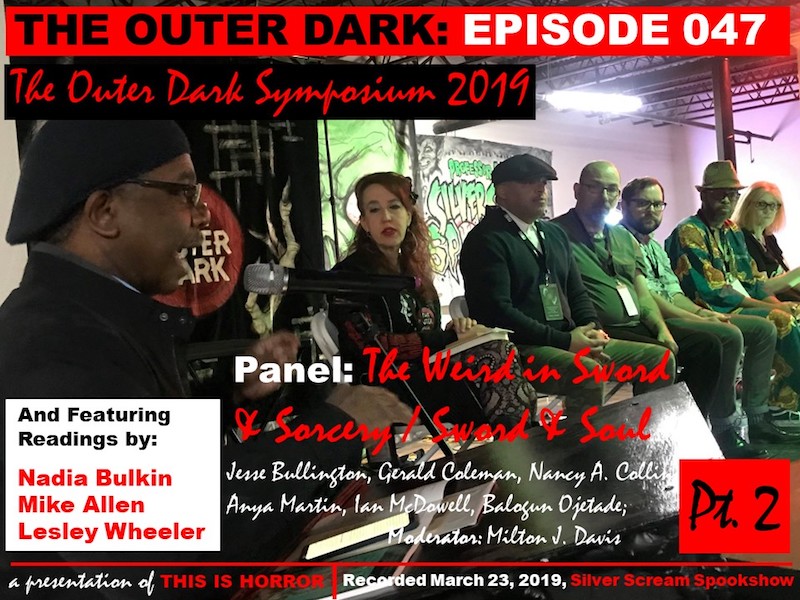 In this podcast The Outer Dark presents the second installment of The Outer Dark Symposium on the Greater Weird 2019 including the panel: ‘The Weird in Sword & Sorcery/Sword & Soul’, moderated by Milton J. Davis and featuring Jesse Bullington, Gerald L. Coleman, Nancy A. Collins, Anya Martin, Ian McDowell, and Balogun Ojetade, as well as readings by Nadia Bulkin, Mike Allen, and Lesley Wheeler. These segments were recorded live on Saturday March 23 at Silver Scream FX Lab in Atlanta, GA. Find out more and listen here.
In this podcast The Outer Dark presents the second installment of The Outer Dark Symposium on the Greater Weird 2019 including the panel: ‘The Weird in Sword & Sorcery/Sword & Soul’, moderated by Milton J. Davis and featuring Jesse Bullington, Gerald L. Coleman, Nancy A. Collins, Anya Martin, Ian McDowell, and Balogun Ojetade, as well as readings by Nadia Bulkin, Mike Allen, and Lesley Wheeler. These segments were recorded live on Saturday March 23 at Silver Scream FX Lab in Atlanta, GA. Find out more and listen here.
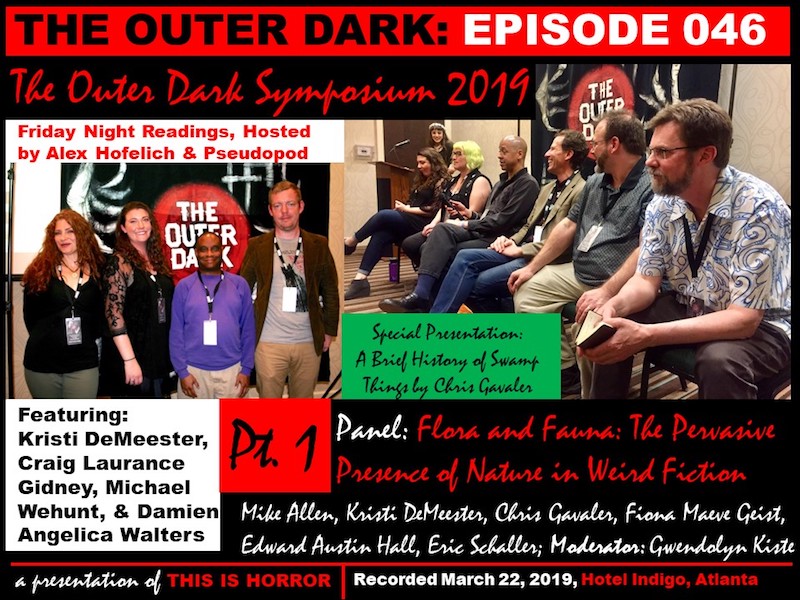 In this podcast The Outer Dark presents the first installment of The Outer Dark Symposium on the Greater Weird 2019 including Friday Night Readings Presented by PseudoPod hosted by Alex Hofelich and featuring Kristi DeMeester, Craig Laurance Gidney, Michael Wehunt, and Damien Angelica Walters, ‘A Brief History of Swamp Things’ presentation by Chris Gavaler, and the symposium’s first panel: ‘Flora and Fauna: The Pervasive Presence of Nature in Weird Fiction’, moderated by Gwendolyn Kiste, and featuring Mike Allen, Kristi DeMeester, Chris Gavaler, Fiona Maeve Geist, Edward Austin Hall, and Eric Schaller. These segments were recorded live on Friday March 23 at Hotel Indigo-College Park in Atlanta, GA. Find out more and listen here.
In this podcast The Outer Dark presents the first installment of The Outer Dark Symposium on the Greater Weird 2019 including Friday Night Readings Presented by PseudoPod hosted by Alex Hofelich and featuring Kristi DeMeester, Craig Laurance Gidney, Michael Wehunt, and Damien Angelica Walters, ‘A Brief History of Swamp Things’ presentation by Chris Gavaler, and the symposium’s first panel: ‘Flora and Fauna: The Pervasive Presence of Nature in Weird Fiction’, moderated by Gwendolyn Kiste, and featuring Mike Allen, Kristi DeMeester, Chris Gavaler, Fiona Maeve Geist, Edward Austin Hall, and Eric Schaller. These segments were recorded live on Friday March 23 at Hotel Indigo-College Park in Atlanta, GA. Find out more and listen here.
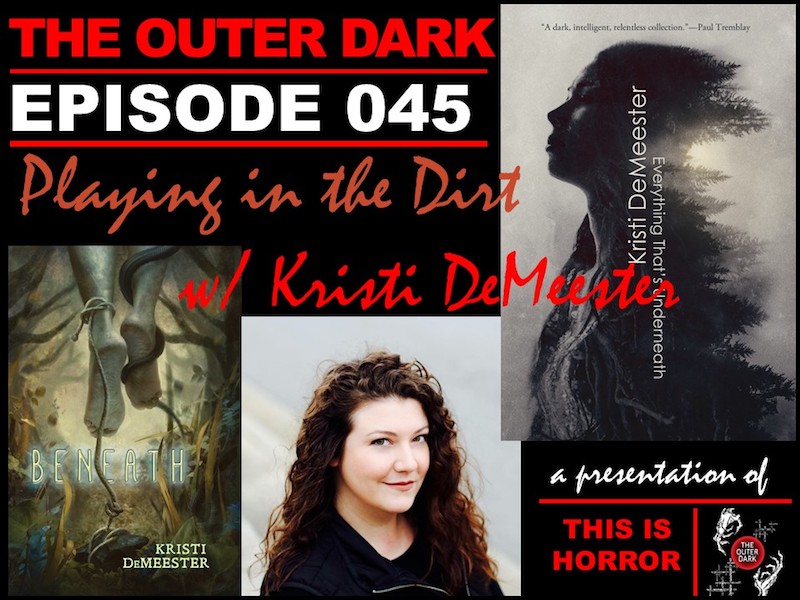 In this podcast Scott Nicolay interviews Kristi DeMeester, author of Beneath (Word Horde) and Everything That’s Underneath (Apex), and a The Outer Dark Symposium 2019 guest. The podcast was recorded on Monday March 18, 2019. Find out more and listen here.
In this podcast Scott Nicolay interviews Kristi DeMeester, author of Beneath (Word Horde) and Everything That’s Underneath (Apex), and a The Outer Dark Symposium 2019 guest. The podcast was recorded on Monday March 18, 2019. Find out more and listen here.
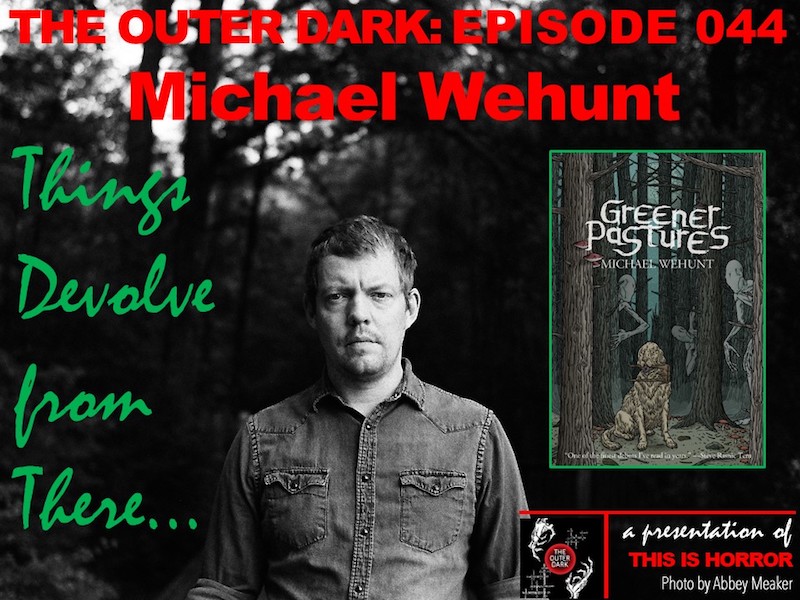 In this podcast Scott Nicolay interviews Michael Wehunt, author of Shirley Jackson Award-nominated Greener Pastures (Apex, 2016) and The Outer Dark Symposium 2019 guest. The podcast was recorded on Tuesday March 5, 2019. Find out more and listen here.
In this podcast Scott Nicolay interviews Michael Wehunt, author of Shirley Jackson Award-nominated Greener Pastures (Apex, 2016) and The Outer Dark Symposium 2019 guest. The podcast was recorded on Tuesday March 5, 2019. Find out more and listen here.
© 2025 Scott Nicolay
Theme by Anders Noren — Up ↑